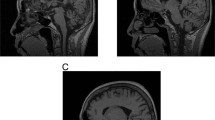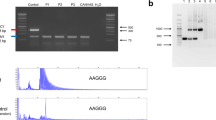Abstract
Dentatorubral and pallidoluysian atrophy (DRPLA) is an autosomal dominant neurodegenerative disorder characterized by combined systemic degeneration of the dentatofugal and pallidofugal pathways. We investigated a candidate gene and found that DRPLA patients had an expanded CAG trinucleotide repeat in a gene on the short arm of chromosome 12. The repeat size varied from 7–23 in normal individuals. In patients one allele was expanded to between 49–75 repeats or occasionally even more. Expansion was usually associated with paternal transmission and only occasionally with maternal transmission. Repeat size showed a close correlation with age of onset of symptoms and disease severity. We conclude that DRPLA is the seventh genetic disorder known to be associated with expansion of an unstable trinucleotide repeat.
This is a preview of subscription content, access via your institution
Access options
Subscribe to this journal
Receive 12 print issues and online access
$209.00 per year
only $17.42 per issue
Buy this article
- Purchase on Springer Link
- Instant access to full article PDF
Prices may be subject to local taxes which are calculated during checkout
Similar content being viewed by others
References
Smith, J.K., Gonda, V.E. & Malamud, N. Unusual form of cerebellar ataxia: Combined dentato-rubral and pallido-Luysian degeneration. Neurology 8, 205–209 (1958).
Neumann, M.N. Combined degeneration of globus pallidus and dentate nucleus and their projections. Neurology 9, 430–438 (1959).
Naito, H. & Oyanagi, S. Familial myoclonus epilepsy and choreoathetosis: Hereditary dentatorubral-pallidoluysian atrophy. Neurology 32, 798–807 (1982).
Takahashi, H. et al. Hereditary dentatorubral-pallidoluysian atrophy: Clinical and pathologic variants in a family. Neurology 38, 1065–1070 (1988).
Kondo, I. et al. Exclusion mapping of the hereditary dentatorubropallidoluysian atrophy gene from the Huntington's disease locus. J. med. Genet. 27, 105–108 (1990).
Takiguchi, Y. et al. A clinical analysis of 11 cases in a family of dentatorubropallidoluysian atrophy (DRPLA). (in Japanese) Dokkyo Medical J. 7, 283–289 (1992).
La Spada, A.R., Wilson, E.M., Lubahn, D.B., Harding, A.E. & Fischbeck, K.H. Androgen receptor gene mutations in X-linked spinal and bulbar muscular atrophy. Nature 352, 77–79 (1991).
La Spada, A.R. et al. Meiotic stability and genotype-phenotype correlation of the trinucleotide repeat in X-linked spinal and bulbar muscular atrophy. Nature Genet 2, 301–304 (1992).
Oberlé, I. et al. Instability of a 550-base pair DNA segment and abnormal methylation in fragile X syndrome. Science 252, 1097–1102 (1991).
Yu, S. et al. Fragile X genotype characterized by an unstable region of DNA. Science 252, 1179–1181 (1991).
Verkerk, A.J.M.H. et al. Identification of a gene (FMR-1) containing a CGG repeat coincident with a breakpoint cluster region exhibiting length variation in fragile X syndrome. Cell 65, 905–914 (1991).
Harley, H.G. et al. Expansion of an unstabie DNA region and phenotypic variation in myotonic dystrophy. Nature 355, 545–546 (1992).
Buxton, J. et al. Detection of an unstable fragment of DNA specific to individuals with myotonic dystrophy. Nature 355, 547–548 (1992).
Aslanidis, C. et al. Cloning of the essential myotonic dystrophy region and mapping of the putative defect. Nature 355, 548–551 (1992).
Brook, J.D. et al. Molecular basis of myotonic dystrophy: Expansion of a trinucleotide (CTG) repeat at the 3′ end of a transcript encoding a protein kinase family member. Cell 68, 799–808 (1992).
Mahadevan, M. et al. Myotonic dystrophy mutation: An unstable CTG repeat in the 3′ untranslated region of the gene. Science 255, 1253–1255 (1992).
Fu, Y.-H. et al. An unstable triplet repeat in a gene related to myotonic muscular dystrophy. Science 255, 1256–1258 (1992).
The Huntington's Disease Collaborative Research Group. A novel gene containing a trinucleotide repeat that is expanded and unstable on Huntington's disease chromosomes. Cell 72, 971–983 (1993).
Orr, H.T. et al. Expansion of an unstable trinucleotide CAG repeat in spinocerebellar ataxia type I. Nature Genet. 4, 221–226 (1993).
Knight, S.J.L. et al. Trinucleotide repeat amplification and hypermethylation of a CpG island in FRAXE mental retardation. Cell 74, 127–134 (1993).
Riggins, G.J. et al. Human genes containing polymorphic trinucleotide repeats. Nature Genet. 2, 186–191 (1992).
Li, S.-H., Mclnnis, M.G., Margolis, R.L., Antonarakis, S.E. & Ross, C.A. Novel triplet repeat containing genes in human brain: cloning, expression, and length polymorphisms. Genomics 16, 572–579 (1993).
Duyao, M. et al. Trinucleotide repeat length instability and age of onset in Huntington's disease. Nature Genet 4, 387–392 (1993).
Snell, R.G. et al. Relationship between trinucleotide repeat expansion and phenotypic variation in Huntington's disease. Nature Genet. 4, 393–397 (1993).
Andrew, S.E. et al. The relationship between trinucleotide (CAG) repeat length and clinical features of Huntington's disease. Nature Genet. 4, 398–403 (1993).
Kurosawa, H., Yamada, M. & Nakagome, Y. Restriction fragment length polymorphisms of the human N-myc gene: relationship to gene amplification. Oncogene 2, 85–90 (1987).
Tadokoro, K., Fujii, H., Inoue, T. & Yamada, M. Polymerase chain reaction (PCR) for detection of Apal polymorphism at the insulin like growth factor II gene (IGF2). Nucl. Acids Res. 19, 6967 (1991).
Sambrook, J., Fritsch, E.F. & Maniatis, T. Molecular cloning: a laboratory manual 2nd edn (Cold Spring Harbor Laboratory Press, New York, 1989).
Tadokoro, K. et al. Intragenic homozygous deletion of the WTI gene in Wilms' tumor. Oncogene 7, 1215–1221 (1992).
Adams, M.D. et al. Sequence identified of 2,375 human brain genes. Nature 355, 632–634 (1992).
Phillips, S.C. & Turner, P.C. A transcriptional analysis of the gene encoding mouse U7 small nuclear RNA. Gene 116, 181–186 (1992).
Author information
Authors and Affiliations
Rights and permissions
About this article
Cite this article
Nagafuchi, S., Yanagisawa, H., Sato, K. et al. Dentatorubral and pallidoluysian atrophy expansion of an unstable CAG trinucleotide on chromosome 12p. Nat Genet 6, 14–18 (1994). https://doi.org/10.1038/ng0194-14
Received:
Accepted:
Issue Date:
DOI: https://doi.org/10.1038/ng0194-14
This article is cited by
-
Pallidal degenerations and related disorders: an update
Journal of Neural Transmission (2022)
-
circRNA Regulates Dopaminergic Synapse, MAPK, and Long-term Depression Pathways in Huntington Disease
Molecular Neurobiology (2021)
-
DRPLA: understanding the natural history and developing biomarkers to accelerate therapeutic trials in a globally rare repeat expansion disorder
Journal of Neurology (2021)
-
Exploring the Potential of Small Molecule-Based Therapeutic Approaches for Targeting Trinucleotide Repeat Disorders
Molecular Neurobiology (2020)
-
Clinical and magnetic resonance imaging features of elderly onset dentatorubral–pallidoluysian atrophy
Journal of Neurology (2018)



